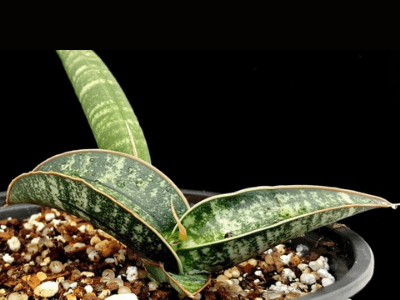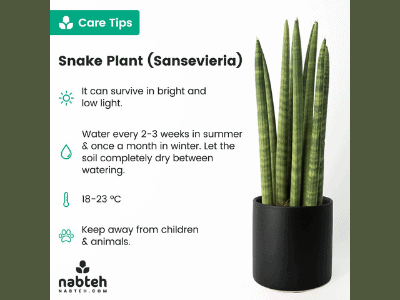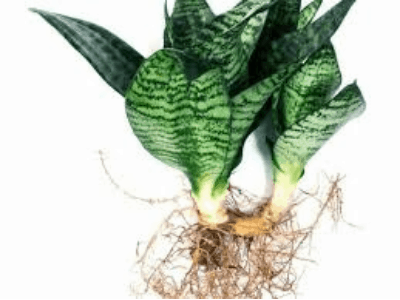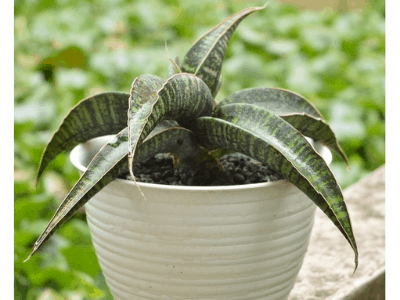Have you heard of Sansevieria fischeri?
It is one of the types of snake plants available out there…
… for you to collect and care for!
Hear it from Lori!
The first time I heard of the Sansevieria fischeri…
I thought that it was a kind of fish that you can actually eat…
Turn out, Sansevieria fischeri is a plant!
In fact, it is one type of the snake plant family…
I was curious about it, so I decided to buy it…
Along with that, I was also intrigued with the idea that snake plant…
… is a really ideal plant for a beginner gardener like myself!
So, what a perfect match we are…
How about you?
Do you know what a Sansevieria fischeri is?
If you don’t, this article will introduce you to what it is…
… alongside the care you have to give for them.
But if you do have them already…
… it’s a perfect time that you came across this article!
Let’s dive in…
Sansevieria: Mother-in-Law’s Tongue

Do you know Sansevieria Fischeri? Or do you know Sansevieria itself?
Sansevieria is one of the most well-known plants on the planet.
Indoors or out, the snake plant makes an excellent potted plant.
“Who hasn’t heard of snake plants?”
Sansevieria, or snake plant, belongs to the Asparagaceae family…
… and is pronounced (san-se-vi-ee’-ri-ah).
It’s also known by other names: Mother-in-tongue, Law’s snake tongue…
… and Bowstring-hemp are all “politically correct” herbs.
Snake Plants Care

Snake plants are very easy to care for, in fact….
… they are similar to most succulent species in terms of care.
Snake plants grow quickly if properly cared for…
… and they make excellent propagation plants.
Because of the shape of their large, flat leaves, they easily collect dust…
… and begin to look unattractive if not dusted on a regular basis.
You must be careful…
… not to damage the leaves or cause scarring while doing this…
Sansevieria varieties are resistant to a wide range of pests and diseases…
Checking your plant’s leaves, root system, and soil for signs of pests or diseases is a good idea…
Regular potting soil is not suitable for snake plant species…
… because it is far too dense for them to thrive.
To keep the roots from suffocating, pot them in cactus or succulent soil that is porous and drains well…
Growing Zone and Light

The 2012 USDA Plant Hardiness Zone Map is the standard by which gardeners and growers can determine which plants are most likely to thrive at a location. The map is based on the average annual minimum winter temperature, divided into 10-degree F zones.
United States Department of Agriculture
If grown outdoors, it’s best in zones 9b-11…
… Sansevieria necessitates 70-90 percent of direct sunlight.
Partially shaded areas are often the best, depending on your location…
Sansevieria Fischeri should be brought indoors or protected…
… during the winter months if they live in the northern end of their growing zone.
The patio zone is 4b-11, which means that in colder climates…
… the potted plant will thrive during the summer months but must be brought inside before winter.
Sansevieria Fischeri
Sansevieria fischeri is distinguished from other Snake Plants by its distinctive curved leaves…
Sansevieria fischeri is one of the smaller Snake Plant varieties…
… reaching a mature height of less than 16 inches.
It’s a great plant for container gardening, but it also thrives in the outdoors…
The plant produces an inflorescence with a cluster of tubular white flowers in the summer…
This Snake Plant variety thrives in areas with plenty of sunlight and good drainage…
Because it is not a frost-tolerant plant, bring it inside…
… or cover it if the temperature drops below freezing.
Fischeri Leopard Bat Sansevieria thrive in a well-drained organic cactus mix…
… that can be found at any big box store. Remember to avoid soils that are wet or mucky…
How to Grow and Care Sansevieria Fischeri
Add organic matter and fertilize; if you have a blooming problem…
… fertilize before the blooming season; if the plant is young (from seeds or late planting)…
… protect it in the winter in hardiness zones 8-10a.
What is the most effective way to begin growing?
Propagating Sansevieria Fischeri
Division

When the plant is fully grown, it is best to separate the shoots…
… after wetting the soil to make it easier and to keep the roots as long as possible.
After planting, increase the amount of water for at least two weeks…
… preferably longer, until the first leaf appears.
Leaf Cuttings
Propagation by cutting leaf, cut the leaves or cut in the base of the leaf…
… with a sharp object and wait at least 24 hours, or if not cut in the base or it is a stem…
… wait a few days until the tissue heals and the care is not wet…
… then place it in well-drained soil and water it every few days to two weeks…
… letting it dry but not completely dry, after a few weeks to months it begins to grow root…
Seed
No, it’s more difficult to start from seeds than it is to start from a cutting or a daughter plant…
… and the plant doesn’t bloom much, so seeds are harder to come by.
Temperature range: 22-28°C (seeds can withstand a wide temperature range)…
… sunny location with good drainage.
Seeds should be saved and cared for until they are ready to be sown…
Location should be dry and dark. Spring to summer in hardiness zone 10…
Possible all year in hardiness zone 11+ 20*30cm (8*12 inches), 2*2cm (1*1 inch) for transplant…
Soil that is moist and humid. Use a small amount of water to keep the soil moist but not soggy, and don’t let it dry out.
Planting Season
Spring in hardiness zone 10a, spring through autumn in hardiness zones 10b-11a, and all year in hardiness zone 11b+.
Planting in a location with good drainage is important…
… because the plant does not like and may die if it sits in a puddle…
… so in a rainy location, grow above ground level and use raising bad pests and diseases.
Here’s some bad pest that may be occurred…
Aphids, snails, slugs, weevils, spider mites Throughout the year, but especially in the winter in colder areas…
Trim just part of the leaf (the dead part) 1cm (0.5 inch)…
… below the dead part if you have old leaves or dead plants.
Sansevieria Fischeri Growth Speed
After the plant has established itself and with proper fertilization, it will grow slowly…
Small amounts of water / average amounts of water are important…
… as is soil drainage; if drainage is poor, reduce the amount of water used…
… and let the soil dry between waterings.
Light Conditions
Full Sun / Half Shade / Full Shade (with light): When moving a plant from shade to full sun…
… gradually expose it to the sun; when planting it directly in full sun…
… choose cooler days with some clouds to give the plant enough time…
… to establish and adjust to its new surroundings.
Is It Possible To Grow Sansevieria Fischeri Indoors?
Because there are no predators for the pests, cleaning it before putting it in the house is necessary…
The shade in the house may cause problems, and the plant may not bloom…
Growing in a pot, planter, flowerpot, or container is also an option…
Yes, when growing in a pot, you can start with a 5L (1.5 gallon) container…
… but this is only for a few plants connected together.
To get an impressive and blooming plant, you’ll need at least 15-20L (4-5 gallons), and shallow is preferable…
However, to get flowers after a few years, you’ll need to check that the roots system does not fill the entire planter..
If it does, you’ll need to reduce the number of plants and cut the roots…
Every few years, check the soil to see if it’s still viable, and if it isn’t…
… clean it out and replace it with new soil. It’s best to use potting mix or something similar.
Is It Possible To Plant Sansevieria Fischeri Outdoors?

At the nursery these Sansevieria are grown under 20-40% shade cloth…
If you plant this Sansevieria in a brightly lit area you may experience leaf burn…
It is best to acclimate this plant to its environment by keeping it outside…
… and slowly moving it into a sunny area over a week or two to avoid stress before planting.
To sum it up…
See having Sansevieria fischeri is good choice for you to have! It’s cool, its famous, it’s easy to have and care!
What else do you need? In this pandemic time like this, is a good choice for you to have an new activity…
…and having snake plant is a good choice for you to have!
Conclusion
Last thing for sure. This plant need to be care carefully, remember plant need the “love” too.
Alright that’s all for today! Do you have any questions about all of this?
Or do you want to add some method for caring and having Sansevieria Fischeri?
Let me know your recommendation from the comment below
Check out more of our posts like this one here!
I hope you can now take care your snake carefully and grow it big! Thanks for reading this article! Bye!

